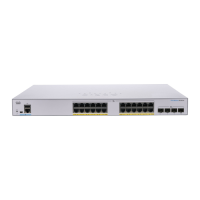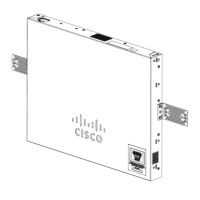• The SFP+ ports (if present) are compatible with the following Cisco SFP 1G optical modules
MGBSX1, MGBLX1, MGBLH1, MGBT1, as well as other brands.
• The SFP+ ports are compatible with the following Cisco SFP 1G optical modules MGBSX1,
MGBLX1, MGBLH1, MGBT1, as well as other brands.
• The Cisco SFP+ Copper Cable modules that are supported in the Cisco switches are:
SFP-H10GB-CU1M, SFP-H10GB-CU3M, and SFP-H10GB-CU5M.
• The LEDs of the corresponding RJ-45 port flash green to respond to the SFP interface traffic.
• Small form-factor pluggable (SFP) ports are connection points for modules, so the switch can link to
other switches.
• Some SFP interfaces are shared with one other RJ-45 and SFP+ port, called a combo port. When the SFP
is active, the adjacent RJ-45 port is disabled.
• Reset button is used to reset or reboot the switch. The table below displays the reset behavior on the
switch.
Old Behavior (Firmware prior to
3.2)
New Behavior (Firmware 3.2 and
on)
Press Type
ReloadSystem LED is green, releasing
button does not cause reload.
1- 5 seconds
ReloadSystem LED flash green,
releasing button during this period
will cause device reload, but
system is not set to factory
default.
6- 10 seconds
Factory defaultSystem LED is green, releasing
button does not cause reload
11-15 seconds
Factory defaultSystem LED flashes green,
releasing button during this period
will cause device reload to factory
default
16-20 seconds
Factory defaultSystem LED is green, releasing
button does not cause reload
> 20 seconds
Stack Behavior
The reset button disable setting is applied to all units in the stack, meaning
that if configured, the reset button on all units in the stack are disabled, and
if not configured the reset button on all units in the stack are enabled. This
applies also to units that join an existing stack.
Note
Get To Know Your Switch
8
Get To Know Your Switch
Front Panel

